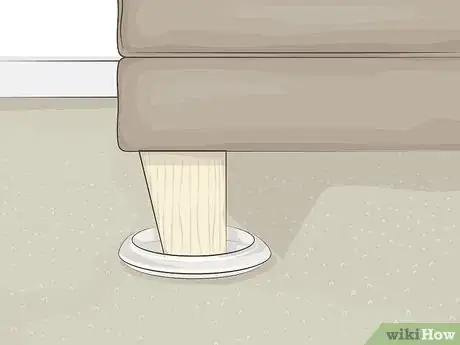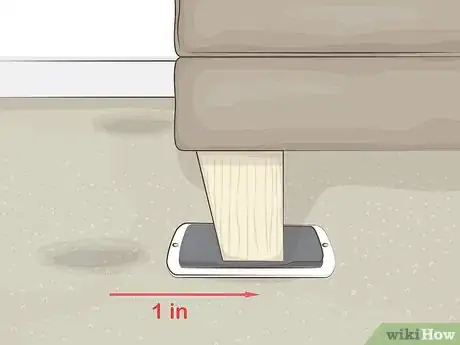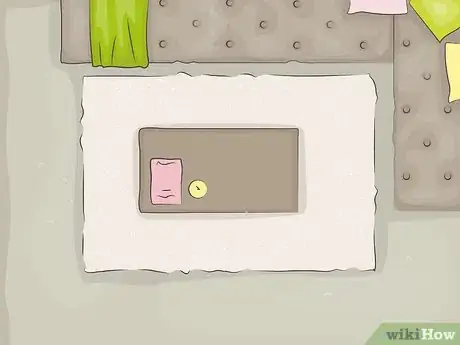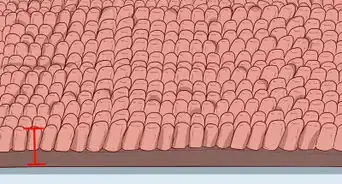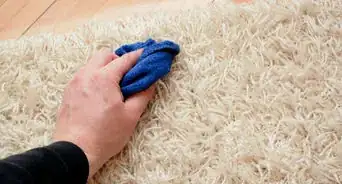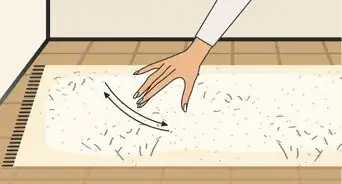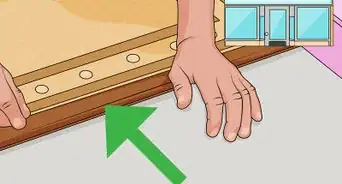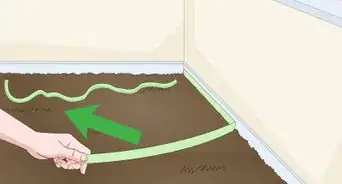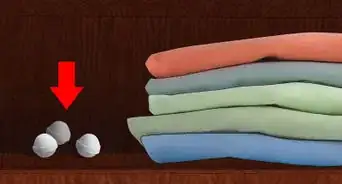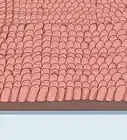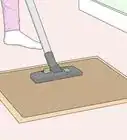This article was co-authored by Austin Reinders. Austin Reinders is a Rug Cleaning & Restoration Expert, as well as the President of Simonian Rug Cleaners in San Mateo, California. He specializes in cleaning oriental rugs. Simonian Rug Cleaners has been in the business of cleaning and repairing rugs for almost 70 years.
This article has been viewed 82,524 times.
Carpet dents are a common problem in many homes. These divots, ranging from small to rather large, are usually caused by the weight of heavy furniture. To avoid these dents in the first place, place your furniture on coasters and move the pieces around regularly. Vacuuming your carpet regularly and placing rugs in strategic places can also minimize denting. If you do see carpet dents, you can remove them by carefully applying ice cubes to the area.
Things You Should Know
- Slide furniture coasters under sofas and tables to protect your carpet from dents.
- Put rugs under furniture and in high-traffic areas of your home to keep heavy items from denting your carpet.
- Move heavy furniture at least once a month to release pressure off your carpets.
Steps
Protecting the Carpet Surface
-
1Use furniture coasters. These are flat disks that go under furniture legs and distribute the weight of the furniture over a wider area, which keeps the carpet from denting. Lift up each of the legs of your furniture and place a coaster underneath them. Furniture coasters range in quality from simple rubber products to decorative glass.
- As always, be careful when moving or lifting your furniture, especially if it’s heavy. Get help from friends with this process or hire professional movers.
- There are also furniture coasters that are called “caster cups.” These coasters have spikes that sink into the carpet to prevent dents. The spikes help to keep the coasters in place, too.
-
2Move your furniture every month. Adjusting the position of your furniture, especially the heavy pieces, each month will help to prevent the deepest dents. The furniture will need to be moved out of the current dent and at least 1 inch (2.5 cm) away. Be careful that your furniture doesn’t tear into the carpet when you move it.
- It might help to use furniture slides to move your heaviest pieces. These are thin plastic pieces that slide under the legs and help you to move heavy furniture around.
Advertisement -
3Vacuum your carpet at least once a week. Even if your carpet doesn’t appear dirty on the surface, it probably has tiny dust and debris weighing down the fibers. Running your vacuum over your carpet helps to lift up the fibers, making them appear less crushed or dented.If you see a deep dent, apply the vacuum suction attachment to the area.
- Experiment with your vacuum’s suctions settings to see which one gets the best results for your carpet type. Most vacuums have adjustments for low, medium, and high pile carpets.
-
4Place rugs in high-traffic areas and under furniture. After you’ve created the furniture layout of each room, decide if a rug would work under any large, heavy pieces of furniture. This will remove some of the weight burden from the carpet. Repeated foot traffic can also cause low-grade dents, so try to lay rugs in areas where people will be walking back and forth repeatedly.[1]
- For example, if you have a carpeted hallway, a rug can minimize the wear to the center part of the carpet.
- If you place rugs under furniture, they may become dented over time. It can help to move them a bit every few months.
Repairing Carpet Dents
-
1Apply ice cubes to the dented areas. The cubes should fully cover the dents, so you’ll need more if there’s a lot of damage. Then, let the ice melt into the carpet for at least 3 hours. Dab the carpet with a cloth or sponge to remove any excess moisture and revive the texture.[2]
- When the carpet is damp, use a spoon to gently lift up any fallen fibers. You’ll want to get down near to the carpet to see exactly which fibers need to be fixed.
- Depending on the size of the dents, you may need to repeat this process multiple times to see results. Wait until the carpet fully dries before trying again.
-
2Blow dry the carpet dents. Start by spritzing the dented areas with water until they are saturated. Then, put your blow dryer on a low heat setting. Hold it 4 to 6 inches (10 to 15 cm) away from the carpet dent. Blow dry the dented area until it is fully dry. Repeat with other dents.[3]
- As you blow dry, run your fingers through the carpet to add texture.
-
3Iron over the dents. Moisten a dish cloth or towel until it is saturated. Then, place this towel flat on top of the dented area. Put your iron on a medium heat setting and allow it to warm up. Then, apply the iron to the towel for 30 seconds to 1 minute. Pull up the towel and fluff the fibers with your fingers.[4]
- Move the iron in small circular motions above the dent to even out the heat application.
- Don’t allow the iron to touch the carpet fibers or it will burn them. The iron should only have contact with the dampened towel or cloth.
Installing Dent-Resistant Carpeting
-
1Select high-density carpet. You can easily determine if a carpet is high density by folding over the sample. Then, look for the backing between the fibers. A high-density carpet will not show the backing. It will cost more, but will withstand the strain of heavy furniture better. It will also be more comfortable and last longer.[5]
- A long pile height doesn’t necessarily mean that a carpet is dense. If each fiber is very thin, then it will still dent easily.
-
2Choose firm carpet padding. Look for a firm, thin pad. Press your fingers into the pad and look for one that provides the most resistance. A thick carpet pad may reduce noise and be more comfortable to walk on, but it allows carpet to flex too much and increases the chances that carpet will develop dents. A pad that isn't firm enough will be permanently crushed by heavy furniture.[6]
- Always install a fresh carpet pad with new carpet. If you create multiple layers of pads, then you’ll get a ripple effect on the carpet’s surface.
-
3Hire a professional for installation. Installing carpet on your own without expert guidance can lead to a lumpy, easily dented floor. Most carpet and flooring stores can recommend contractors to you who have experience with installation. Check their references and reviews personally before moving forward.[7]
- Most reputable contractors will also come out to your home and provide an estimate for your carpet installation project.
- If an installer doesn’t listen to your concerns about durability and denting, hire another person to do the job.
Warnings
- In some cases, denting can cause certain carpet fibers to appear longer than others. Don't pull these fibers out or you'll damage the carpet.⧼thumbs_response⧽
Things You’ll Need
- Furniture coasters or caster cups
- Furniture slides
- Vacuum
- Rugs
- Ice cubes
- Cloth or sponge
- Blow dryer
- Iron
- High-density carpet
- Firm carpet padding
Expert Interview
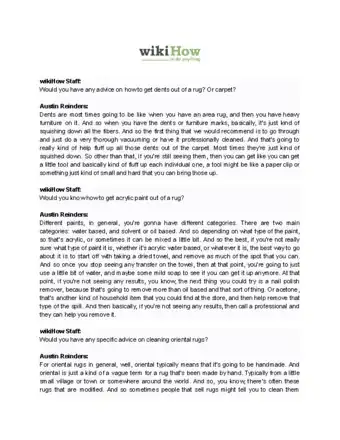
Thanks for reading our article! If you'd like to learn more about repairing and cleaning carpets and rugs, check out our in-depth interview with Austin Reinders.
References
- ↑ https://www.angieslist.com/articles/4-tips-clean-and-revive-carpet-pile.htm
- ↑ https://www.bobvila.com/articles/how-to-get-dents-out-of-carpet/
- ↑ https://www.bobvila.com/articles/how-to-get-dents-out-of-carpet/
- ↑ https://www.bobvila.com/articles/how-to-get-dents-out-of-carpet/
- ↑ http://extension.usu.edu/files/publications/factsheet/HI_05.pdf
- ↑ http://extension.usu.edu/files/publications/factsheet/HI_05.pdf
- ↑ https://www.angieslist.com/articles/4-tips-clean-and-revive-carpet-pile.htm
